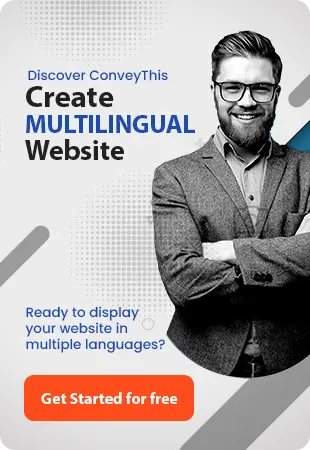如今,许多网站都提供多种语言选项,让来自世界各地的访客都能轻松浏览。互联网将市场变成了一种全球体验,让企业能够接触到更广泛的受众。但是,如果您的网站只支持一种语言,您可能会疏远无法理解您内容的潜在客户。提供多语言网站可确保用户能够以他们喜欢的语言或母语与您的网站互动,从而提高参与度和转化率。
创建多语言网站并不复杂。ConveyThis 等现代工具使翻译过程变得无缝,让您只需几分钟即可创建一个完全翻译的网站。本文探讨了多语言网站设计技巧,从确保品牌一致性到解决文化差异,帮助您设计一个能引起全球目标受众共鸣的网站。
多语言网站的重要性
对于希望扩大影响力并与不同受众建立有意义的联系的企业来说,拥有一个多语言网站至关重要。让我们来看看为什么创建一个多语言网站会改变游戏规则:
1. 接触更广泛的受众
单语网站会将您的覆盖范围限制在只说该语言的用户。通过提供翻译,您可以将网站开放给更广泛的受众,让来自不同地区和文化背景的人们与您的品牌互动。
2. 改善用户体验
当用户能够以自己喜欢的语言浏览时,他们会觉得浏览您的网站更舒服。这可以改善用户体验,增加用户在网站上停留的时间,并降低跳出率。
3.提高搜索引擎排名
搜索引擎优先考虑本地化内容。将您的网站翻译成多种语言并针对搜索引擎进行优化可提高您的全球知名度,吸引来自不同地区的自然流量。
4. 增加信任和转化
客户更有可能信任迎合其母语的网站。这种信任意味着更高的转化率和更牢固的客户关系。
单语网站的困难
在当今互联互通的世界里,运营单语网站面临诸多挑战。虽然单语网站可能适合拥有同质受众的本地企业,但它会严重限制旨在吸引国际目标受众的公司的增长和全球影响力。在这里,我们探讨了单语网站的困难,以及为什么采用多语网站策略对于成功至关重要。
1.对更广泛受众的可访问性有限
单语网站仅供理解其所用语言的个人访问。考虑到全球只有约 16% 的人口会说英语,绝大多数潜在客户可能会发现您的网站无法访问。例如:
- 即使法语访客对您的产品或服务感兴趣,他们也可能会难以浏览仅限英语的网站。
- 如果西班牙语用户找不到自己喜欢的语言,他们可能会避免接触您的内容。
这种有限的可访问性限制了您接触更广泛受众的能力,如果没有灵活的布局,就会阻碍您的增长潜力。
2.用户体验差
语言障碍会导致无法理解内容的用户感到沮丧和困惑。糟糕的用户体验会导致:
- 当访问者意识到自己无法理解网站内容时,他们就会很快离开网站,从而导致跳出率更高。
- 减少与产品描述、表格或支持页面等关键元素的互动。
- 网站导航困难,特别是在结账等重要流程中。
以受众的母语提供内容本地化和灵活的布局对于创造积极和直观的用户体验至关重要。
3. SEO挑战
单语网站错过了多语言 SEO内容本地化带来的巨大好处,包括:
- 本地化关键词定位:如果没有多种语言的内容,您只能针对一种语言的关键词进行优化,这会严重限制您在国际搜索结果中的可见性。
- Hreflang 实施:缺少 hreflang 标签意味着搜索引擎无法正确地将您的内容与特定地区或语言关联,从而降低其相关性。
- 全球排名:单语网站在非本土市场排名较低,这意味着它们无法出现在潜在国际客户的搜索结果中。
这些挑战大大减少了您的网站从其他国家吸引的自然流量。
4.转化率较低
转化率与用户浏览网站时的舒适度和自信度直接相关。单语网站通常会导致:
- 废弃的购物车:如果客户不完全了解条款、产品详细信息或付款方式,他们会犹豫是否完成购买。
- 信任问题:用户可能会认为单语网站包容性较差或专业性较差,尤其是当他们在关键交互过程中无法找到自己喜欢的语言时。
- 错失的机会:即使您的产品吸引了国际观众,但缺乏翻译也会疏远潜在买家。
例如,如果产品描述和退货政策仅提供英文,来自德国的购物者可能会离开您的网站。
5.无法满足多样化市场的需求
单语网站采用一刀切的方法,无法满足不同地区的偏好和文化差异。请考虑以下场景:
- 英文网站可能无法引起日本用户的共鸣,因为特定文化的图像、颜色和术语至关重要。
- 由于语言使用的区域差异,墨西哥的西班牙语用户可能会觉得与针对西班牙西班牙语使用者的网站脱节。
为了有效地服务全球目标受众,您的网站必须满足每个市场的特定需求和期望。
6.客户支持方面的挑战
提供优质的客户支持对任何企业来说都至关重要,但单语网站会让国际用户的这一过程变得复杂:
- 如果支持资源、常见问题解答和联系表只有一种语言,非母语人士可能很难找到帮助。
- 客户服务互动中的沟通不畅可能会导致不满意和销售损失。
多语言网站通过提供多种语言的资源和沟通渠道简化了客户支持。
7.错失营销机会
单语网站限制了您创建个性化和针对特定地区的营销活动的能力。没有翻译,您无法:
- 投放定向广告:如果没有本地化内容,则不可能在 Google Ads 或 Facebook 等平台上开展特定语言的广告活动。
- 发送定制电子邮件:如果国际订阅者无法理解邮件内容,电子邮件营销活动就无法与他们建立联系。
- 利用影响力人士:如果其他地区的影响力人士的受众无法访问您的网站,那么与他们合作的效果就会降低。
拓展国际市场需要本地化的营销努力,而单语网站无法支持这一点。
8.缺乏竞争优势
在日益全球化的市场中,许多竞争对手已经推出了多语言网站。单语网站可能会落后,因为:
- 参赛者可以更有效地接触并吸引全球观众。
- 多语言网站被视为更具包容性、专业性和以客户为中心。
如果未能采用多语言方法,您的业务将会面临很大的不利因素。
9.全球扩张难度
随着企业的发展,他们自然会寻求拓展国际市场。然而,扩展单语网站存在重大障碍:
- 地区特定问题:单一语言网站无法满足不同市场的不同需求,例如货币兑换或地区特定法规。
- 分散的解决方案:为每种语言建立单独的网站需要大量的时间、精力和资源。
多语言网站为全球发展提供了可扩展的基础,简化了扩展过程。
解决方案:采用多语言网站
克服单语网站的困难首先要采用多语言网站策略。通过提供多种语言的内容本地化,您可以:
- 接触更广泛的受众并开拓新的市场。
- 通过满足访客的首选语言来增强用户体验。
- 通过优化的多语言 SEO实践来提高搜索引擎排名。
- 通过解决文化和语言偏好来建立信任并提高转化率。
ConveyThis 等工具使翻译过程变得无缝衔接,帮助您创建专业、可扩展且用户友好的多语言网站。从自动检测语言到灵活的设计调整,ConveyThis 可确保您的网站吸引多样化的目标受众,同时又不损害其可用性或品牌形象。
有效的多语言网站设计技巧
创建多语言网站不仅仅是简单的网站翻译。设计必须适应不同的语言、文化偏好和用户期望。一个可扩展的网站如果能有效地融入本地化,可以增强受众参与度,并确保跨地区的无缝浏览体验。以下是一些设计灵活布局的实用技巧,可支持多种语言和不同的用户需求。
1. 跨语言的一致品牌
无论用户访问的是哪个语言版本,用户体验都需要保持一致。即使进行必要的本地化调整,外观和感觉也应保持统一。在语言之间切换的访问者不应该感觉他们进入了一个完全不同的网站。
灵活布局和品牌风格等设计元素应在所有语言中保持一致。ConveyThis 等工具可准确识别文本并无缝处理网站翻译,即使在使用其他插件时也是如此,从而简化了此过程。
一致的全球设计模板不仅可以节省添加新语言的时间,还可以支持可扩展的网站基础架构。例如,Airbnb 在不同语言中保持相同的主题和功能,从而打造出精致、一致的用户体验。
日文版如下:
毫无疑问,这是同一个网站。背景相同,搜索功能也相同。统一的设计有助于您的品牌识别,并在添加新语言或更新时节省时间和精力。
2. 清晰易用的语言切换器
在每个页面的显眼位置突出显示语言切换器,确保所有用户都能轻松访问。易于查找的选项可提高受众参与度,因为访问者无需搜索隐藏功能即可切换语言。
为了更好地进行本地化,请以语言名称的母语形式显示(例如,“Español”而不是“Spanish”)。这种方法创造了一种包容性的体验,并确保您的网站翻译工作让人感觉真实。Asana 的语言选择下拉菜单是一个很好的例子,说明直观的设计如何提高可用性。
3. “语言”比“地区”更好
许多大型国际品牌要求您切换地区,以便能够以您的语言阅读网站。这是一个糟糕的想法,让访客的浏览变得更加困难。这些网站假设您是在使用该语言的地区浏览,因此您可以获得以您的语言编写的文本,但可能无法获得您感兴趣的地区的内容。
以下图片取自Adobe网站:
语言不应该与地域密不可分。以纽约、伦敦和巴黎等所有国际大都市为例。也许住在英国的比利时人想从英国网站购买商品,但要用法语浏览。他们必须在使用自己语言的比利时网站和使用英语的英国网站之间做出选择,但他们都不想这么做。因此,您无意中创建了障碍。让我们来看看一个允许您分别指定语言和地区的网站,即 Uber 网站。
这是出色的设计。在本例中,语言切换选项被放置在左侧的页脚中,由于选项众多,因此您有一个模式而不是下拉框。语言名称也以其自己的语言来引用。
作为奖励,您可以“记住”用户选择的语言,因此从第一次访问开始他们就不必再切换。
4. 自动检测位置
此功能非常有用,这样您的访问者就不会使用错误的语言进行访问。还可以节省用户的时间,使他们不必寻找语言切换器。它的工作原理是:网站识别浏览器使用的语言或他们的位置。
但如果用户是游客并且不熟悉当地语言,则要小心,因为他们需要语言按钮才能进行切换,因此该工具并不总是准确的。
当设计您的多语言网站时,不要在自动检测语言和语言切换器之间做出选择,后者是强制的,而前者是可选的。
5. 标志不适合替代语言名称
有 21 个讲西班牙语的国家和 18 个讲英语的国家,而在中国,有 8 种主要方言,因此旗帜并不能很好地替代语言名称。此外,旗帜可能不是有用的指示符,因为它们可能会让那些不认识它们的人感到困惑。
6.灵活运用文本空间
这可能是一个挑战,但不可否认的是,翻译并不占用与原文相同的空间,有些可能更短,有些可能更长,有些甚至可能需要更多的垂直空间!
中文信息量大,不需要太多空间,而意大利语和希腊语则更加冗长,需要两倍的行数。一个好的经验法则是,假设某些翻译可能需要超过 30% 的额外空间,因此要灵活安排布局,为文本留出充足的空间。原网站空间狭小,可能根本没有足够的空间容纳翻译内容。英语是一种特别紧凑的语言,如果您发现需要用英语缩写来容纳内容,那么翻译时肯定会遇到一些麻烦。
除了为文本提供伸展空间之外,拥有自适应 UI 元素也是一个好主意,这样按钮和输入字段也可以增大,您也可以减小字体大小,但不要太多。
Flickr 网站是多语言的,我们来看看原始的“查看”按钮:
它看起来很棒,一切都很棒,但是“views”在其他语言中是一个更长的词,需要更多的空间。
在意大利语中它需要三倍的空间!
许多非拉丁文字(例如阿拉伯语)需要更高的高度才能容纳翻译。总而言之,您的网站布局应该足够灵活,以适应不同的语言要求,这样在转换时,原始的精美外观才不会丢失。
7. Web 字体兼容性和网站编码
根据 W3C,强烈建议您使用 UTF-8 对网页进行编码,以便使用特殊字符。
这很简单,UTF 声明如下所示
还要确保字体与不同语言兼容,否则文本可能看起来难以辨认。基本上,在决定使用任何字体之前,请检查其与您需要的所有脚本的兼容性。如果您想进入俄罗斯市场,请检查是否支持西里尔文。
下面的图片取自 Google Fonts,如您所见,您可以选择下载所需的任何脚本版本。字符数量较多的语言会产生较大的字体文件,因此在选择和混合字体时要考虑到这一点。
关于从右到左的语言
随着中东市场的增长,您可以考虑创建一个吸引该地区访客的网站版本,这意味着调整布局以使其与他们的语言兼容。大多数中东语言的一个特点是它们从右到左阅读!这是一个巨大的挑战,解决方案从镜像界面开始。
这是 Facebook 针对从左到右的语言(例如英语)的设计。
这是针对从右到左的语言(例如阿拉伯语)的翻转设计。
仔细观察,设计中所有事物的放置都已镜像。
请参阅 Robert Dodis 关于从右到左语言设计的文章以获取有关如何执行此操作的更多信息。
一些从右到左的语言包括阿拉伯语、希伯来语、波斯语和乌尔都语,ConveyThis 可以轻松调整您的网站以适应他们的语言要求并确保出色的用户体验。最好的是,您可以自定义每种语言的外观并更改字体类型或大小,并在必要时编辑行高。
8.选择合适的图标和图像
视觉效果具有非常浓厚的文化成分,是正确网站设计的关键要素。每种文化都会为不同的图像和图标赋予意义,有些解释是积极的,有些则完全相反。有些图像反映了一种文化的理想体验,但在不同的背景下,它会让用户感到疏远。
以下是一张因为不符合文化背景而不得不更换的图片的示例。请注意,并非所有图片都会冒犯他人,当您想让人们对您的产品产生好奇和兴趣时,它也许只会让人产生冷漠。
这是娇韵诗的法语版主页,上面是一位白人女性。这是娇韵诗的韩语版主页,上面是一位韩国女性作为品牌形象大使。
某些视觉内容在某些文化中看似无害,但在另一个文化中却被视为非法或禁忌的行为,例如对同性恋或女性赋权的描述,可能会引起反感。
这也适用于图标,而在美国,带有两个香槟酒杯的图标代表庆祝,而在沙特阿拉伯,饮酒是违法的,因此必须用符合文化的图标替换该图标。
因此需要进行研究以确保您选择的图标适合目标市场。如果您不确定,您可以谨慎行事。
例如,这三个以地球为主题的图标,第一个是为澳大利亚观众设计的;第二个是为非洲观众设计的;最后一个适合更大的全球观众,因为没有涉及特定的区域。
最后但同样重要的是,ConveyThis 可以翻译任何文本,只要它没有嵌入图像即可。软件将无法识别其上所写的内容,因此它将保留原始语言,因此请避免嵌入文本。
9. 颜色选择
如上一节所述,不同文化对图像的解读不同,颜色也是如此。它们的含义是主观的。
例如,在某些文化中,白色是纯真的颜色,但其他人不同意,它是死亡的颜色。红色也是如此,在亚洲文化中,它用于庆祝,但对于一些非洲国家来说,它没有那么积极的内涵,因为它与暴力有关。
然而,蓝色似乎是所有颜色中最安全的,通常与平静、和平等积极意义联系在一起。许多银行在其徽标中使用蓝色,因为它也可以表示信任和安全。
本文展示了世界各地颜色含义的差异,对于您开始研究什么颜色最适合您的多语言网站非常有用。
10. 格式调整
考虑避免在写日期时只使用数字,因为有很多不同的写法,在美国,官方格式是 mm/dd/yyyy,如果您只能看到数字,来自使用不同系统(例如 dd/mm/yyyy)的其他国家/地区的一些用户可能会感到困惑。因此,您的选择是:确保翻译版本的日期格式经过调整,或者用字母写月份,这样 ConveyThis 总是会写出正确的日期。
此外,虽然美国使用英制,但大多数国家都使用公制,因此您需要确定您的站点是否适合进行测量转换。
WordPress 的最佳翻译插件
在向 WordPress 网站添加翻译插件时,有很多选择,但并非所有插件的工作方式都相同,结果也会有所不同。使用 ConveyThis,无论您的网站设计如何,都能保证完美集成。
ConveyThis 是网站翻译的最佳选择,提供 92 种语言。这是一款可靠的 WordPress 插件,可让您快速拥有可靠的多语言网站版本。它可以理解网站的布局,检测所有文本并进行翻译。ConveyThis 还包括一个直观的文本自定义编辑器。
ConveyThis 包含一个通用的语言切换按钮,默认适用于任何网站,但您也可以根据需要对其进行编辑。我们还遵循本文所述的设计原则:
- 网站所有语言版本均采用一致的品牌形象。
- 清晰的语言切换器和选择首选语言的选项。
- 网站自动使用 UTF-8 编码。
- 适合从右到左语言的界面
ConveyThis:您可以信赖的多语言网站解决方案
创建多语言网站并不复杂。使用ConveyThis,翻译过程无缝、快速且对初学者友好。这款功能强大的工具可让您将网站翻译成多种语言,而不会破坏其设计或功能。
ConveyThis 的主要优点:
- 快速设置:安装插件,选择语言,几分钟内即可开始使用。
- 自动翻译:检测并翻译所有内容,包括产品描述、表格和应用程序生成的文本,同时保持格式。
- 可定制的翻译:使用可视化编辑器优化翻译并使其适合您的目标受众。
- 专业服务:聘请专业语言学家进行精确且符合文化背景的翻译。
- SEO 优化:包括 hreflang 标签、本地化 URL 和元数据翻译,以提高全球搜索引擎排名。
- 可扩展以适应增长:随着业务的扩展,轻松添加语言并管理翻译。
无论您是首次构建多语言网站还是拓展新市场,ConveyThis 都能确保顺利过渡,提升用户体验并扩大全球影响力。借助其 14 天免费试用,现在是让您的网站实现多语言化的最佳时机!
其他资源:
- ConveyThis Integrations 探索与 WordPress 的兼容性。
- 如何翻译 WordPress 以获取更多指导。
- 翻译 WordPress 网站的帮助指南,提供逐步支持。
翻译不仅仅是了解语言,它是一个复杂的过程。
通过遵循我们的提示并使用 ConveyThis ,您翻译的页面将会引起受众的共鸣,让他们感觉就像目标语言一样。
虽然需要付出努力,但结果却是值得的。如果您正在翻译网站,ConveyThis 可以通过自动机器翻译为您节省数小时。
免费试用ConveyThis 3 天!
 没有银行卡详细信息
没有银行卡详细信息



